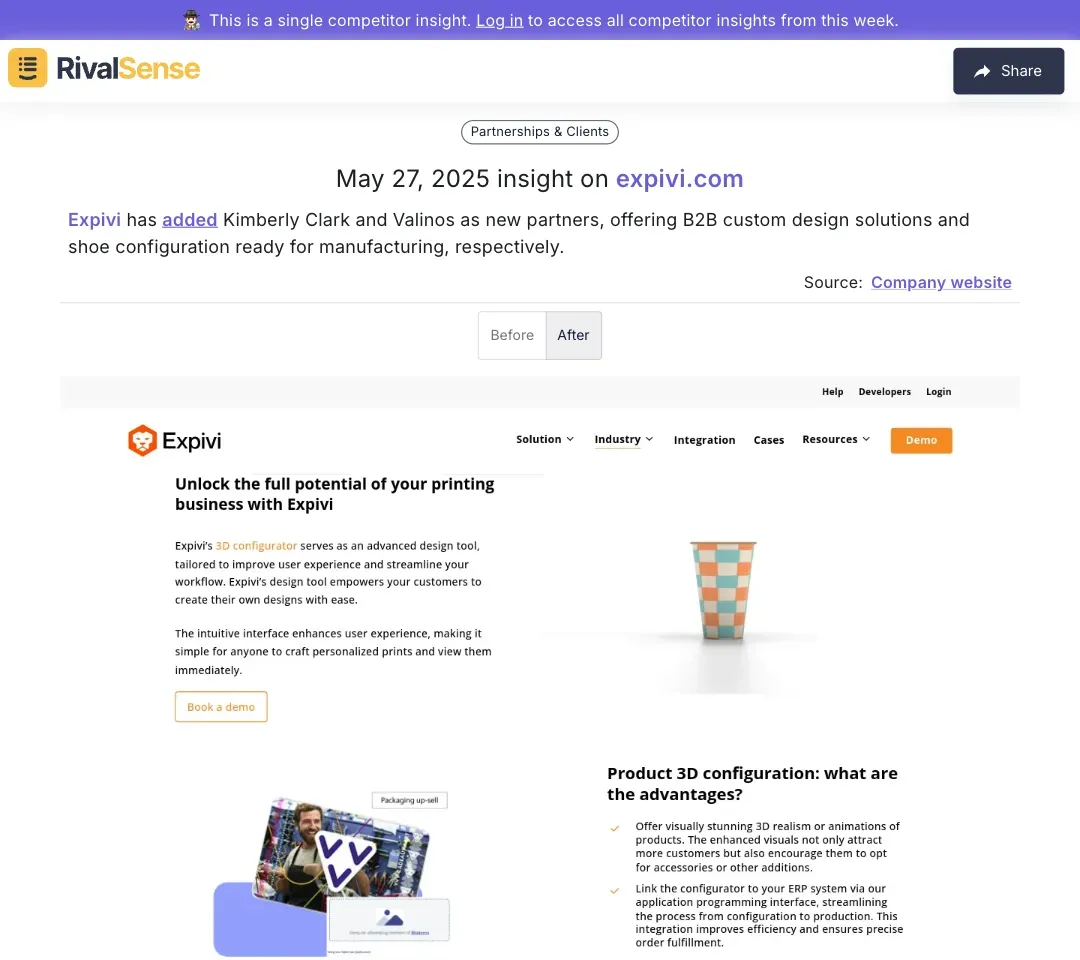🚫 Avoid These 4 Costly Mistakes in Competitor Thought Leadership Analysis
In the competitive landscape of B2B markets, understanding your competitors' thought leadership is not just about keeping tabs—it's about uncovering strategic insights that can shape your own business strategy. Competitor thought leadership analysis goes beyond surface-level observations; it delves into the themes, channels, and engagement strategies that resonate with your shared audience. Common objectives include identifying content gaps, spotting emerging trends, and benchmarking brand authority—but many companies stumble by focusing on vanity metrics rather than actionable intelligence.
Tools like RivalSense streamline this process by tracking competitor activities across websites, social media, and registries, delivering weekly reports on product launches, partnerships, and media mentions. Let’s explore the most common pitfalls and how to avoid them.
Mistake 1: Overlooking Strategic Partnership Shifts
Strategic partnerships are a goldmine for competitor analysis, yet many businesses fail to track these alliances. Shifts in collaborations often signal pivots in business strategy or responses to market trends. For example, a sudden partnership between a SaaS company and a logistics firm could hint at an expansion into supply chain solutions.

Example: Expivi added Kimberly Clark and Valinos as partners, revealing a focus on B2B customization. Tracking such changes helps predict competitors' market positioning.
Why It Matters
- Strategic Alignment: Partnerships reflect priorities (e.g., Expivi’s new focus on manufacturing-ready solutions).
- Trend Indicators: Terminated collaborations (like GEM Electric Vehicles) may signal shifting customer demands.
Actionable Steps
- Monitor Announcements: Use automated tools to track partnership changes in real time.
- Analyze Impact: Ask: Does this collaboration fill a capability gap or expand market reach?
- Compare Strategies: Identify gaps in your own partnership portfolio.
🔍 Pro Tip: RivalSense users spotted Expivi’s partnership shift with Ralph Lauren and Hypedome (see report), revealing their focus on error reduction in customization—a trend competitors later adopted.
Mistake 2: Ignoring Customization & Innovation Signals
Customization and innovation are critical differentiators in B2B markets. Competitors who excel here often redefine customer expectations. For instance, when a rival launches AI-driven product configurators, it signals a shift toward self-service solutions.
Key Analysis Areas
- Product Updates: Track feature enhancements (e.g., "error reduction" in manufacturing workflows).
- Content Themes: Are competitors emphasizing personalization in whitepapers or webinars?
- Customer Feedback: Monitor reviews for mentions of tailored solutions.
✅ Checklist
- [ ] Compare your customization capabilities quarterly
- [ ] Map competitors' innovation timelines
- [ ] Analyze pricing changes post-innovation
Mistake 3: Underestimating New Market Entrants
Startups and cross-industry players often disrupt markets with niche solutions. A fintech startup partnering with healthcare providers, for example, could redefine payment workflows before incumbents react.
Early Warning Signs
- Unusual Partnerships: Non-traditional alliances (e.g., SaaS + manufacturing)
- Rapid Hiring: Sudden growth in R&D teams
- Funding Announcements: Series B+ rounds indicating scalability
📈 Case Study: When RivalSense detected a new entrant’s IoT platform for HVAC systems, clients adjusted their roadmaps to preempt disruption.
Mistake 4: Neglecting Industry Trend Context
Analyzing competitors without industry context is like reading a book missing every third page. For example, if sustainability regulations tighten, a competitor’s new eco-friendly product line isn’t just innovation—it’s compliance.
Trend Integration Framework
| Step | Action | Tool Example |
|---|---|---|
| 1 | Track regulatory changes | RivalSense regulatory alerts |
| 2 | Map competitor responses | Social media sentiment analysis |
| 3 | Align with internal strategy | SWOT analysis |
Conclusion: Turn Insights Into Action
Effective competitor analysis requires avoiding these four mistakes while leveraging the right tools. By monitoring partnership shifts, innovation signals, new entrants, and industry trends, you’ll stay ahead of market curves.
🚀 Ready to streamline your analysis?
Try RivalSense Free to get automated competitor reports tracking product launches, partnerships, and regulatory changes—delivered weekly. Claim your first report today and turn competitive intelligence into actionable strategy.
📚 Read more
👉 Decoding Competitor Moves: How to Predict Event Participation & IP Strategies
👉 Market Intelligence Mastery: Strategic Positioning Insights for B2B Leaders 🚀
👉 When a Competitor Hires a CFO: How Executive Moves Reshape Your Strategy
👉 Mastering LinkedIn Competitor Insights: Drive Customer Success & Outperform Rivals
👉 Mastering Competitor SWOT Analysis in Wood Manufacturing: A Strategic Guide for Leaders
